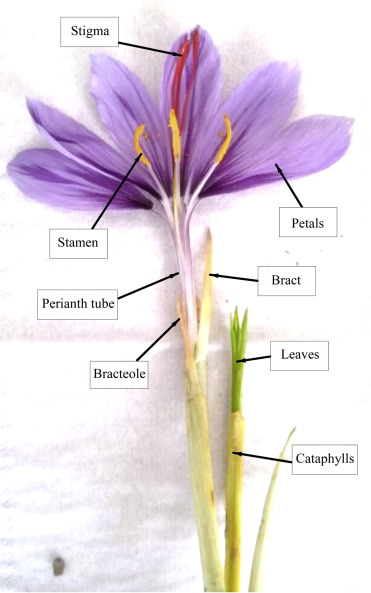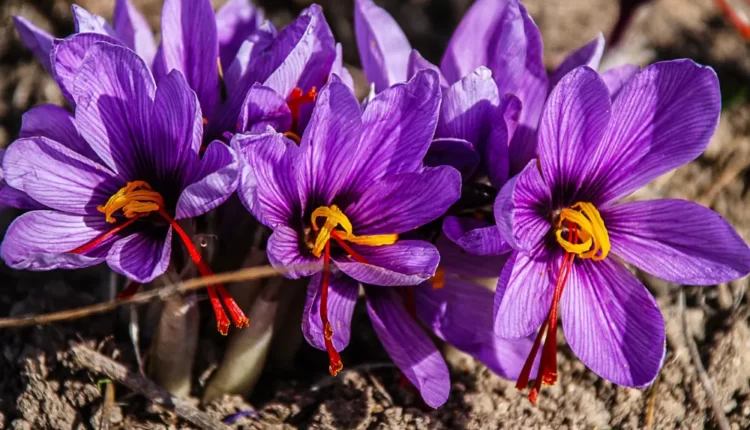Saffron is an agricultural product that is used as a spice and seasoning in cooking due to its aroma and color. The presence of two compounds, crocin and safranal, in saffron gives it medicinal properties, which are also used in the medical industry.
Saffron is one of the most expensive spices in the world and is also known as “red gold”. If we examine the reason for the high cost of saffron, the first point we come across is the rarity of this plant in the world.
The podcast of this article

What is saffron?
how does it grow?
Most plants reproduce through seeds, but saffron is propagated through saffron bulbs. Saffron bulb cultivation was first taught to other countries by Iranians.
After planting saffron bulbs in the soil, the purple saffron flower emerges from the top of the bulb.
After pollination, you are faced with a beautiful purple flower with six petals that protect three red stigmas. These three red stigmas are the same pigment that is very laboriously prepared.
Types of original saffron
There are several different types of saffron, and each type can have different characteristics depending on factors such as the method of harvesting, the separation of the stigmas (decreasing the weight of the saffron), the climate of the region, and ultimately, the quality of the saffron.
We have listed the types of saffron from the highest quality to the lowest quality.
Super Negin saffron
Semi Negin saffron
Negin saffron
Sargol saffron
Pushal saffron
Bunch of saffron (or Dokhtar-Pich girl)
If you want to learn more about each of these types of saffron, I suggest reading an article specifically about different types of saffron.
However, it’s worth noting that Super Negin saffrons is considered the best and most expensive type of saffron, while Sargol saffron is one of the most popular types and can be found abundantly in the market.
Saffron Anatomy
The saffron flower is composed of several parts, including petals, stigmas, stamens, leaves, and a bulb. In the image below, we have shown the pattern of saffron.

Components of saffron
| Crocin | explains the yellow pigmentation from the stigmas |
| picrocrocin | gives the rusty, bittersweet taste |
| Safranal, | lends the honey-hay-like scent to the herb |
| Lycopene | these carotenoids are also present in tomato compounds |
| Beta-carotenes | These carotenoids are also present in carrot compounds. |
| Zeaxanthin | Picrocrocins are an incomplete version of the carotenoid zeaxanthin, produced through oxidative cleavage. |
In the above table, you can see the names of the Components that make up saffron, each of which contributes to the unique properties of saffron.
The quality and purity of saffron are determined in laboratories by measuring these compounds. The higher the percentage of these compounds, the higher the quality of saffron, which in turn has a significant impact on the properties and price of saffron.
what is the colors saffron?
Saffron itself is not a color, but rather a spice that is known for its distinctive reddish-orange color. When saffron is added to food or other substances, it can impart its characteristic color. Additionally, saffron is often used as a natural dye for textiles and other materials, producing shades of yellow, orange, and red.
Mountain or wild saffron
The saffron that we are more familiar with has purple petals and is used as a spice. There is another type of saffron that grows naturally and has mostly white leaves. The bulb of mountain saffrons is edible and can be used in food.
The most important properties of saffron
Before delving into the properties of saffron in detail, it is useful to provide you with a list of the saffron benefits :
– Antidepressant
– Pain relief
– Prevention of hair loss
– Improvement of respiratory health
– Improvement of cardiovascular health
– Improvement of mental health
– Improvement of skin health
– Enhancement of digestive system
– Boosting intelligence
– Effective in the treatment of high blood pressure and blood sugar
– Women suffering from irregular periods or painful periods can benefit from timely consumption of saffron
– Diabetes can be controlled and prevented by consuming saffrons
– Treatment of gout can be done by this plant
– Saffron helps improve men’s sexual life
– Individuals suffering from stomach and abdominal pain due to cold food can get rid of this condition by consuming saffron
– The body needs moderation when consuming too much cold food, which saffron can help with
– Coldness may manifest itself with chills, which saffron can help treat
– Sleep disorders, urinary disorders, and memory disorders can be treated with the help of this fragrant and colorful plant
– This warm and dry plant is the best detoxifier
– There is a simple treatment for MS, and that is the medicinal use of saffrons
– It helps improve metabolism and leads to increased energy and weight loss.”
How to use saffron and its limitations
The most important point to consider when using saffron is its authenticity. Adulteration of saffrons by adding impurities to increase profits is common.
If you intend to buy saffron, our recommendation is to purchase it from a reputable store that specializes in the saffron industry.
Alongside all the benefits we have mentioned about this flower, it is also important to know its limitations so that you do not overuse it:
– Overconsumption of saffrons can lead to poisoning and even death.
– Excessive consumption (more than 50 milligrams) can cause body overheating and affect some internal organs such as the liver.
– The use of this substance is recommended for pregnant women under special conditions.
– Overuse of this plant can cause miscarriage in the early months of pregnancy.
We hope that with consideration of these items and regular reading of our informative articles, you will gain sufficient knowledge for optimal use of this plant.
What is your opinion about saffron and its extraordinary properties? Please share your comments and experiences with us in the comments section.
What happens if we eat saffron everyday?
According to various reports and research sources, the permissible daily consumption of saffron ranges from 0.1 to 1.5 grams. Additionally, this amount should not be consumed at once but included in daily meals.
Moreover, according to credible sources, consuming only 30 milligrams of saffron daily is enough to benefit from its health benefits. To learn more about the properties of saffron, you can read the article “Properties and Benefits of Saffron for Health.”
Consuming the proper daily amount of high-quality saffron doubles its effectiveness. Therefore, paying attention to the amount, quality, and authenticity of saffron is an important factor that should always be considered.
Who should not take saffron?
Although saffron is a valuable plant, it can harm many people. Some cases where saffron consumption is prohibited include pregnancy, individuals with sweaty palms, and those with unidentified allergies. To learn about the prohibition of saffron consumption, please read the article Is Saffron (Kesar) Safe ?
F&Qs
What is saffron?
Saffron is a spice that is derived from the flower of Crocus sativus, commonly known as the saffron crocus.
What gives saffron its distinctive color and flavor?
Saffron owes its distinctive color and flavor to the chemical compounds crocin and safranal, which are present in the stigmas of the saffron flower.
What are some common culinary uses for saffron?
Saffron is commonly used as a seasoning and coloring agent in a variety of dishes, including paella, risotto, and bouillabaisse.
What are some of the medicinal properties of saffron?
Saffron has been used for centuries in traditional medicine for a variety of ailments, including depression, asthma, and menstrual disorders.
What are some of the challenges associated with saffron production?
Saffron is a labor-intensive crop that must be harvested by hand, making it one of the world’s most expensive spices. Additionally, the quality of saffron can be difficult to assess, as adulteration is common in the industry.
Are there any potential risks associated with consuming saffron?
While saffron is generally considered safe for consumption in small amounts, excessive consumption can lead to poisoning and even death. Additionally, pregnant women should avoid consuming large amounts of saffron, as it may increase the risk of miscarriage. As with any food or supplement, it is important to consult with a healthcare professional before consuming saffron in large amounts or for medicinal purposes.


